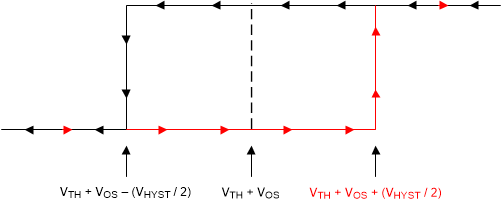SNOSDF0A May 2024 – December 2024 TLV4H290-SEP , TLV4H390-SEP
PRODUCTION DATA
- 1
- 1 Features
- 2 Applications
- 3 Description
- 4 Pin Configuration and Functions
- 5 Specifications
- 6 Typical Characteristics
- 7 Detailed Description
-
8 Application and Implementation
- 8.1 Application Information
- 8.2 Typical Applications
- 8.3 Power Supply Recommendations
- 8.4 Layout
- 9 Device and Documentation Support
- 10Revision History
- 11Mechanical, Packaging, and Orderable Information
8.1.2 Hysteresis
The basic comparator configuration can oscillate or produce a noisy "chatter" output if the applied differential input voltage is near the comparator's offset voltage. This usually occurs when the input signal is moving very slowly across the switching threshold of the comparator.
This problem can be prevented by the addition of hysteresis or positive feedback.
The hysteresis transfer curve is shown in Hysteresis Transfer Curve. This curve is a function of three components: VTH, VOS, and VHYST:
- VTH is the actual set voltage or threshold trip voltage.
- VOS is the internal offset voltage between VIN+ and VIN–. This voltage is added to VTH to form the actual trip point at which the comparator must respond to change output states.
- VHYST is the hysteresis (or trip window) that is designed to reduce comparator sensitivity to noise.
 Figure 8-2 Hysteresis Transfer Curve
Figure 8-2 Hysteresis Transfer CurveFor more information, please see Application Note SBOA219 "Comparator with and without hysteresis circuit".